See also
- Watteau in Venice , a novel
- Watto, a fictional character in the Star Wars universe
Antoine Watteau (1684–1721) was French painter.
Watteau may also refer to:

Jean-Antoine Watteau was a French painter and draughtsman whose brief career spurred the revival of interest in colour and movement, as seen in the tradition of Correggio and Rubens. He revitalized the waning Baroque style, shifting it to the less severe, more naturalistic, less formally classical, Rococo. Watteau is credited with inventing the genre of fêtes galantes, scenes of bucolic and idyllic charm, suffused with a theatrical air. Some of his best known subjects were drawn from the world of Italian comedy and ballet.

Jean-Pierre Norblin de La Gourdaine was a Polish-French painter, draughtsman, engraver and caricaturist. Born in France, from 1774 to 1804 he resided in the Crown of the Kingdom of Poland, where he obtained citizenship.

Events from the year 1721 in art.

The Embarkation for Cythera is a painting by the French painter Jean-Antoine Watteau. It is also known as Voyage to Cythera and Pilgrimage to the Isle of Cythera. Watteau submitted this work to the Royal Academy of Painting and Sculpture as his reception piece in 1717. The painting is now in the Louvre in Paris. A second version of the work, sometimes called Pilgrimage to Cythera to distinguish it, was painted by Watteau about 1718 or 1719 and is in the Charlottenburg Palace, Berlin.
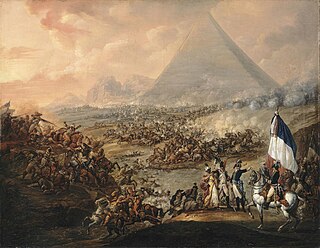
François Louis Joseph Watteau, known like his father as the Watteau of Lille, was a French painter, active in his birthplace. He was the son of the painter Louis Joseph Watteau (1731–1798) and grandson of Noël Joseph Watteau (1689–1756) – Noël was the brother of Jean-Antoine Watteau, the painter of "fêtes galantes". From 1808 to his death, he was deputy curator of the Palais des Beaux-Arts de Lille, which his father had helped to found.
Louis Joseph Watteau, known as the Watteau of Lille was a French painter active in Lille.
Events from the year 1798 in France.

The sack-back gown or robe à la française was a women's fashion of 18th century Europe. At the beginning of the century, the sack-back gown was a very informal style of dress. At its most informal, it was unfitted both front and back and called a sacque, contouche, or robe battante. By the 1770s the sack-back gown was second only to court dress in its formality. This style of gown had fabric at the back arranged in box pleats which fell loose from the shoulder to the floor with a slight train. In front, the gown was open, showing off a decorative stomacher and petticoat. It would have been worn with a wide square hoop or panniers under the petticoat. Scalloped ruffles often trimmed elbow-length sleeves, which were worn with separate frills called engageantes.
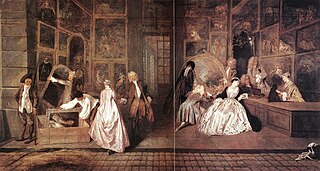
L'Enseigne de Gersaint is an oil on canvas painting in the Charlottenburg Palace in Berlin, by French painter Jean-Antoine Watteau. Completed during 1720–21, it is considered to be the last prominent work of Watteau, who died some time after. It was painted as a shop sign for the marchand-mercier, or art dealer, Edme François Gersaint. According to Daniel Roche the sign functioned more as an advertisement for the artist than the dealer.

The Watteau was an express train that linked Gare du Nord in Paris, France, with Tourcoing in the North of France. The train was named after the French painter Antoine Watteau.
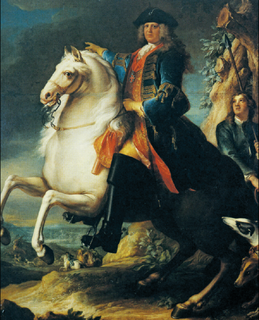
Pierre-Antoine Quillard, was a French portrait painter and engraver who worked in Portugal.
Events from the year 1721 in France.

Christine Antoinette Charlotte Desmares, professionally known as Mlle Desmares, was a French stage actress. Scion of a notable comic actor family, she had an active stage career that spanned three decades, performing with the Comédie-Française from 1699 until her retirement in 1721; she was also remembered as a mistress of Philippe II, Duke of Orléans, Regent of France.
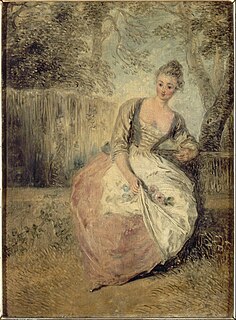
The Worried Lover is an oil on panel painting in the Musée Condé, Chantilly, by the French Rococo artist Antoine Watteau. Variously dated to c. 1715–1720, the painting was among private collections throughout the 18th and 19th centuries, until it has been acquired by Henri d'Orleans, Duke of Aumale, son of King Louis Philippe I; as part of the Duke of Aumale's collection at the Château de Chantilly, The Worried Lover was bequeathed to the Institut de France in 1884.

The Chord, alternatively known as The Serenader and Mezzetino, is an oil on panel painting in the Musée Condé, Chantilly, by the French Rococo painter Antoine Watteau, variously dated c. 1714–1717. Throughout the 18th and 19th centuries, The Chord passed through numerous private collections, until it came into possession of Henri d'Orléans, Duke of Aumale, son of King Louis Philippe I; as part of the Duke of Aumale's collection at the Château de Chantilly, The Chord was bequeathed to the Institut de France in 1884.
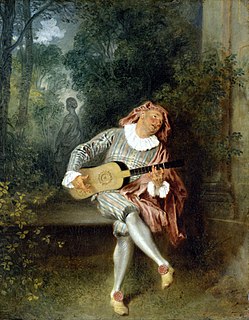
Mezzetino is an oil on canvas painting in the Metropolitan Museum of Art, New York, by the French Rococo painter Jean-Antoine Watteau. Dated within 1717–1720, Mezzetino forms a full-length single-figure composition, depicting the eponymous character in commedia dell'arte. In the 18th century, Mezzetino was owned by Jean de Jullienne, the friend and patron of Watteau who supervised the four-volume edition of prints after the artist's works, for which the picture was engraved by Benoit Audran the Elder; after Jullienne's death in 1766, it was acquired for the Hermitage in Saint Petersburg, then recently established by Empress Catherine II of Russia. During the Soviet sales in the 1920s and 1930s, Mezzetino was sold to British-American businessman Calouste Gulbenkian; it was later sold to the Wildenstein art firm in Paris and New York, from which it was bought in 1934 by the Metropolitan Museum of Art, where it remains; the institution also owns a preparatory study—a drawing of the man's head.

L'Indifférent is a 1717 oil on panel painting by Antoine Watteau, which entered the Louvre in the collection of Louis La Caze in 1869.

Fêtes Vénitiennes is a 1719 painting by Antoine Watteau, now in the Scottish National Gallery in Edinburgh, to which it was bequeathed in 1861 by Lady Murray of Henderland, widow of John Murray, Lord Murray. It takes its title from a 1732 engraving of the work by Laurent Cars and is derived from the Venetian styles of dress and dancing shown in the work, the former inspired by the commedia dell'arte. It belongs to the fêtes galantes genre created by Watteau.
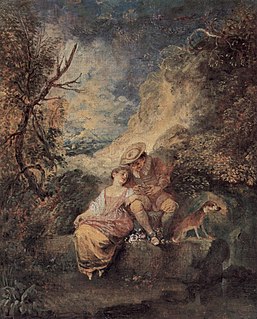
The Robber of the Sparrow's Nest is an oil painting by the French Rococo artist Antoine Watteau, now in the National Galleries of Scotland, Edinburgh. Variously dated between 1709 and 1716, the painting is a pastoral scene that is one of a few extant arabesques in Watteau's art; it shows a young couple with a dog, sitting at a sparrow's nest; it has been thought to be influenced by Flemish Baroque painting, exactly by Peter Paul Rubens' painting from the Marie de' Medici cycle.

The Dreamer is an oil on panel painting of c. 1712–1717 in the Art Institute, Chicago, by the French Rococo artist Antoine Watteau. The painting is a single-figure, full-length composition that shows a seated young woman amid a landscape, dressed in somewhat an exotic attire consisting of long red gown with fur garment and white bonnet; it is a recurring subject that is also present in numerous paintings and drawings by Watteau such as The Coquettes, dit Actors of the Comédie-Française. There were attempts to identify the sitter of the painting, who was notably thought to be Watteau's contemporary, the Comédie-Française actress Charlotte Desmares.